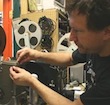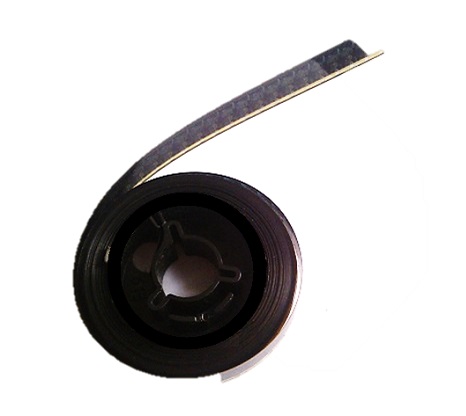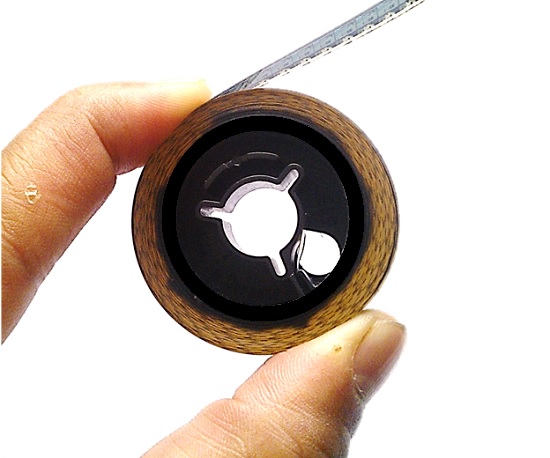|
Author
|
Topic: OSI'S challenge ....
|
Osi Osgood
Film God

Posts: 10204
From: Mountian Home, ID.
Registered: Jul 2005
|
 posted March 07, 2014 12:21 PM
posted March 07, 2014 12:21 PM




Hey everybody, I offered this challenge on the other film forum, and I also offer it here, this is it, (this is largely cut and pasted from my original message) ...
I understand that ****, It probably does limit my sales a little. (referring to the truth that my sales are limited due to these film arriving "cored" in the first place), I think that in the future, if I allow this fellow to send me anymore films, they MUST be on reels in the first place as, quite frankly, It's kind of a hassle in the first place to deals with these cores.
*** does bring up a grand point, therefore, I offer this challenge ...
I have always assumed that for a film to be cored, it is simply not on a reel, but is wound firmly and secured safely with some form of tape ...
Others, (***, *******, for instance), assert that for film to be "cored", it must have some form of "hub" in the middle, be it plastic, metal ect.
Therefore ...
I offer a challenge ...
I have just spent the better part of an hour attempting to find on the internet, ANYTHING that would serve as evidence to either argument, concerning what constitutes a "cored" film.
If anyone can prove, whether from old dusty books (photo please) or from any other source, that for a film to be cored, it must have some central hub on it ....
Then I, upon my word, will publicly apologize to Micheal O Reagan, plus all, on both forums, that I was wrong and will, as of that time, also remove any reference to the term "core" on any further ebay auctions.
I don't think I'm wrong, but I am also not the sum of all knowledge and besides, I LOVE to factually learn anything new about film, so I and all of you benefit as well! ...
Therefore, to the books men! To the internet, men! To any source that is credible, reliable, ect. ![[Big Grin]](biggrin.gif)
and I happily offer that challenge on here as well. Hey, if I'm wrong, I'm wrong and I don't have a problem with that, but I would like to be proven wrong before I alter the way I sell, (for, for all we all know, I might well be right!).
Please note: what will accepted as evidence will be actual authoritative proof, whether internet, books ect, and not just "personal opinion", as I could do that as well, but quite frankly, my opinion doesn't hold anymore water than yours, and visa versa.
All the best, folks!
--------------------
"All these moments will be lost in time, just like ... tears, in the rain. "
| IP: Logged
|
|
|
|
Michael O'Regan
Film God
Posts: 3085
From: Essex, UK
Registered: Oct 2007
|
 posted March 07, 2014 01:47 PM
posted March 07, 2014 01:47 PM



quote:
If anyone can prove, whether from old dusty books (photo please) or from any other source, that for a film to be cored, it must have some central hub on it ....
Oh, for goodness sake! ![[Confused]](confused.gif)
Look, it doesn't really matter one way or the other whether this can be proved or not.
In the film collecting world, the general acceptance is that "Film is cored" means that the print is on cores.
The chances are that your prints will be bought by someone from said film collecting world.
Therefore, I don't understand why you would state "Film is cored" in an auction if there is even the slightest chance that you might mislead a prospective buyer.
None of this makes any sense, Osi.
| IP: Logged
|
|
|
|
|
|
Patrick McGrath
Film Handler
Posts: 97
From: Huntington Beach, CA
Registered: Jul 2008
|
 posted March 07, 2014 04:08 PM
posted March 07, 2014 04:08 PM




I don't really want to get involved here but the most basic meaning of a core is as follows:
"A central and often foundational part usually distinct from the enveloping part by a difference in nature."
And in my limited experience, films are said to be either "on reels" or "on cores", therefore a cored film is assumed to be actually on a core.
So technically, while Osi's films are wound similar to cored films, the lack of the foundational part ie: the core, means that the films are indeed not cored, just wound without a reel.
In the end, it would be up to the pickiness of the buyer as to whether or not this is an issue. As far as terminology, it seems to me that although Osi is incorrect technically, for all intents and purposes his technique seems to result in the same effect as coring.
I would be interested to know that if when using Osi's method, how stable is the wind without the foundation?
Is it more likely to collapse in on itself and wreak havoc?
Or once you have achieved the platter shape, does it remain whole no matter the lack of a core?
| IP: Logged
|
|
|
|
|
|
|
|
|
|
|
|
|
|
|
|
|
|
|
|
|
|
|
|
|
|
|
|
Dino Everette
Phenomenal Film Handler

Posts: 1535
From: Long Beach, CA USA
Registered: Dec 2008
|
 posted March 08, 2014 01:35 AM
posted March 08, 2014 01:35 AM



Here is the definition of the word "core" from the International Federation of Film Archives which was formed in 1938 and is a world organization that sets best practices for handling, storing, projecting film..
CORE
A cylinder used as a centre for winding film, usually plastic, originally wood
The term "core" being used to describe a physical piece of something at the center with film wrapped around it began literally with the original film in the 1890's. In the early days film was wrapped on wooden cores about 1 inch - 1 1/2 inch in diameter from the raw stock to the film placed in the camera and then on the original projectors. A small cylindrical post would be slid through the wooden core to hold it in place on the projector and it would run through the machine and into a basket on the floor.
I believe ALL 35mm motion picture film used in cameras have been on cores since the beginning and still to this day...Reels have only been used for projection, and when the film stock got smaller, Kodak introduced small reels (and cartridges) so that it was easier for the consumer to handle the film in conjunction with cameras.
Paul in addition to the shipping cost concerns, films are put on cores for the following reasons... Most lab machines are so precisely designed that having the film on reels would be detrimental and possibly damage the machine, or cause the film to wrap up loosely, so basically anything coming straight from a film lab (unless it is 8mm) will be on a plastic core...Also since the 1920's the best practice for storing film long term in any sort of horizontal fashion has been on cores...I have attached a small image of an excerpt from a 1921 issue of the Society of Motion Picture Engineers (now SMPTE) that describes this practice.....
You will probably never find an actual definition for the term, because obviously the term "cored" is not a "technical" term, but a slang term only. It has, however grown out of essentially 100 years worth of professional and technical discussions about the handling of film that is wrapped around little wooden, metal and plastic cores.
Even the general definition of the word core stands for a physical "something" at the center of something else.


--------------------
"You're too Far Out Miss Lawrence"
| IP: Logged
|
|
|
|
|
|
|
|
|
|
|
|
|



 UBBFriend: Email this page to someone!
UBBFriend: Email this page to someone!
 Printer-friendly view of this topic
Printer-friendly view of this topic





![[Big Grin]](biggrin.gif)


![[Confused]](confused.gif)








![[Wink]](wink.gif)
![[Smile]](smile.gif)



